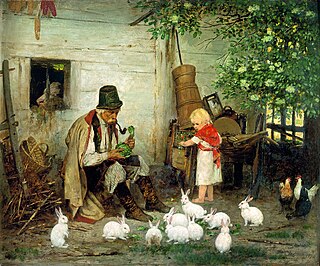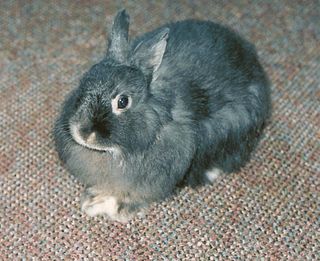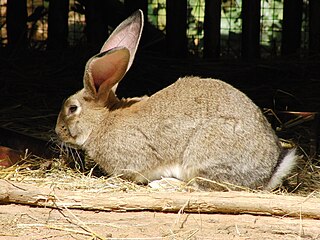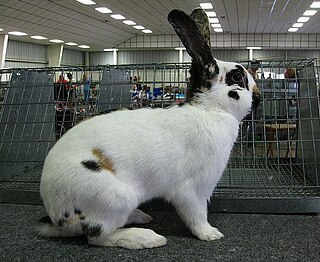Related Research Articles

Cuniculture is the agricultural practice of breeding and raising domestic rabbits as livestock for their meat, fur, or wool. Cuniculture is also employed by rabbit fanciers and hobbyists in the development and betterment of rabbit breeds and the exhibition of those efforts. Scientists practice cuniculture in the use and management of rabbits as model organisms in research. Cuniculture has been practiced all over the world since at least the 5th century.

The Angora rabbit, one of the most ancient groups of domestic rabbit breeds, which is bred for the long fibers of its coat, known as Angora wool. They are gathered by shearing, combing or plucking. Because rabbits do not possess the same allergy-causing qualities as many other animals, their wool is an important alternative. There are at least 11 distinct breeds of Angora rabbit, four of which are currently recognized by the American Rabbit Breeders Association (ARBA): the English Angora, the French Angora, the Giant Angora and the Satin Angora. Other unrecognized breeds include the German Angora, the Finnish Angora, the Chinese Angora, the Japanese Angora, the Korean Angora, the Russian Angora, the St Lucian Angora and the Swiss Angora.

The Netherland Dwarf is a breed of domestic rabbit that originated in the Netherlands. Weighing 1.1–2.5 pounds (0.50–1.13 kg), the Netherland Dwarf is one of the smallest rabbit breeds. Its popularity as a pet or show rabbit may stem from its neotenic appearance. The Netherland Dwarf is recognised by both the American Rabbit Breeders Association (ARBA) and the British Rabbit Council (BRC). The Netherland Dwarf is often confused with the Polish breed of rabbit, but the latter has longer ears, a non-brachycephalic head and less cobbiness.

The Jersey Wooly is a breed of domestic rabbit weighing about 3 pounds with a bold head and wool fur on their body.

The Californian, also known as the California White, is a breed of domestic rabbit initially developed for the fur and meat industries by George S. West of Lynwood, California, starting in 1923. West maintained a herd of 300 genetically pure New Zealand Whites, which he began crossing with Standard Chinchilla rabbits for their dense coat and Himalayan rabbits. This new breed, named after the state of its origin, was first shown in 1928, and a standard was accepted by the American Rabbit Breeders Association (ARBA) in 1939.

The Holland Lop is a breed of lop-eared rabbit that was recognized by the American Rabbit Breeders Association (ARBA) in 1979. The Holland Lop, with a maximum weight of 1.8 kg (4 lb), is one of the smallest lop-eared breeds.

Chinchilla rabbits are a group of three rabbit breeds that have been bred for a coat that resembles that of chinchillas. Despite their name, they are not related to, and cannot interbreed with, chinchillas, a genus of rodent. Rabbits, in contrast, are lagomorphs. A mutation diluted the yellow pigment in the hairs to almost white, changing in this way the color of the fur of the wild type fur (agouti) into chinchilla.

The American Fuzzy Lop is a rabbit breed recognized by the American Rabbit Breeders Association (ARBA). It is similar in appearance to a Holland Lop. However, the American Fuzzy Lop is a wool breed and will have wool similar to the Angora breeds although the wool will be shorter than that of a commercial Angora. The American fuzzy lop has to weigh up to four pounds in order to be shown.

The Flemish Giant rabbit is the largest breed of domestic rabbit. They weigh 6.8 kilograms on average, though the largest ones can weigh up to 22 kilograms. Historically they are a utility breed used for their fur and meat. In the modern day, they are no longer commonly raised for meat, due to their slow growth and very large bones, and are raised for exhibition at rabbit shows. They are often kept as pets as they are known for being docile and patient when being handled.

The English Spot is a breed of domestic rabbit that was developed in England in the 19th century through selective breeding. Averaging 5 to 8 pounds in weight, the English Spot is a medium-sized breed that is most noted by the distinctive colored markings on its body, including the butterfly nose marking, eye circles, cheek spots, herringbone, colored ears, and a chain of spots. The English Spot's fur type is flyback. The breed comes in seven different varieties, including black, blue, chocolate, lilac, tortoise, gray, and gold. English Spots have a full arch body, with long front legs that carry them off the table. English Spots are most known for their curious and fun loving nature.

The term rex rabbit refers informally to one of at least eight breeds of domestic rabbit. One such breed is the Rex, which is recognized by the American Rabbit Breeders Association (ARBA) and by the British Rabbit Council (BRC). Other modern-day rex rabbit breeds are listed below. Care must be taken to distinguish the rex rabbit breeds from the three types of rex rabbit fur for which they are known.

The American Rabbit is a breed of rabbit, recognized by the American Rabbit Breeders Association (ARBA) in 1917. According to the ARBA Standard of Perfection, American rabbits have a mandolin body shape. It has also been noted for a docile temperament and good mothering abilities. As with all domestic rabbits, the American breed is of the species Oryctolagus cuniculus, the European wild rabbit.
The Beveren is one of the oldest and largest breeds of fur rabbits. It was first bred in Beveren, a small town near Antwerp in Belgium. Their coats can be blue, white, black and lilac, though not all of these varieties are ARBA-recognized. There is a rare variety called the Pointed Beveren, which comes in the same colors but has white tipped hairs. The blue variety is the original.

The Checkered Giant, known as Géant Papillon in French, is a breed of domestic rabbit that originated in France. One of the largest rabbit breeds, the Checkered Giant is recognized by the American Rabbit Breeders Association (ARBA). The Checkered Giant is one of the minority of rabbit breeds with specific coat markings. The markings defined in the breed standard of the Checkered Giant differ somewhat from those in the breed standard of the Giant Papillon. For ARBA show purposes, a mature Checkered Giant buck must weigh a minimum of 11 pounds (5.0 kg), and a mature doe must weigh a minimum of 12 pounds (5.4 kg). ARBA does not specify a maximum weight for Checkered Giants.
Plush Lop is a breed of domestic rabbit with two varieties: Miniature and Standard. There is also a Canadian Plush Lop breed in development. Similar in appearance, the Velveteen Lop breed is also in development. Miniature Plush Lops were the first to be developed. Devie D'anniballe began creating this breed in 1995 in the United States. She succeeded in developing them by combining the previously existing breeds of Holland Lop, Mini Rex, and Mini Lop. Her aim was to create the perfect pet by retaining the good qualities of these breeds, while "breeding out" all the problems existing in these breeds.

The Silver Fox rabbit is a rare breed of domestic rabbit developed by Walter B. Garland of North Canton, Ohio, and bred for meat, show, and its unique fur. The breed is recognized by the American Rabbit Breeders Association.

The New Zealand is a breed of rabbit, which despite the name, is American in origin. The breed originated in California, possibly from rabbits imported from New Zealand. New Zealand rabbits are available in five colors recognized by the American Rabbit Breeders' Association (ARBA): white, red, black, blue, and broken. Crossbreeding can result in many other variations, such as gold tipped steel and chestnut agouti. They average 10–12 lb (4.5–5.4 kg) with the does being slightly larger than the bucks. New Zealands are bred for meat, pelts, show, and laboratory uses, being the most commonly used breed of rabbit both for testing and meat production. They are also bred as pet rabbits but mostly breed for meat.

The Rhinelander is a medium-sized breed of domestic rabbit that originated in Germany. Rhinelanders are known for their distinctive facial "butterfly markings", a spine marking, colored ears, cheek spots, eye circles and side markings of black with orange or of blue with fawn. The Rhinelander breed is recognized by the British Rabbit Council (BRC) and by the American Rabbit Breeders Association (ARBA).

Dwarf Hotot is a breed of domestic rabbit characterized by an entirely white coat, except for a circle of another color around each eye.
References
- ↑ "History". Cinnamon Rabbit Breeders Association. Archived from the original on May 11, 2018. Retrieved May 10, 2018.
- ↑ "ARBA Recognized Breeds". American Rabbit Breeders Association. Retrieved November 21, 2022.
- ↑ "Breed Standards 2021-2025" (PDF). British Rabbit Council. Retrieved November 21, 2022.
- ↑ Stone, Lynn M. (2016). Rabbit Breeds: The Pocket Guide to 49 Essential Breeds. Storey Publishing. p. 96.
- ↑ Faria, Diana (May 19, 2016). "Cinnamon Rabbit". PetGuide. Retrieved November 21, 2022.
- ↑ Gendron, Karen (2000). The Rabbit Handbook. Barron's Educational Series. p. 108. ISBN 978-0-7641-1246-1.
- 1 2 "The Cinnamon Rabbit Breed Profile". Pet Peoples Place. Retrieved November 21, 2022.
- ↑ Hankins, Candy. "Choosing a Californian Rabbit". Archived from the original on January 25, 2010. Retrieved November 11, 2009.
- 1 2 "Cinnamon Rabbit". Animal World. Retrieved November 21, 2022.
- 1 2 3 4 5 "The All-Purpose Rabbit". Archived from the original on January 25, 2010. Retrieved November 11, 2009.
- ↑ "Frequently Asked Questions". ARBA. Archived from the original on February 7, 2012. Retrieved February 18, 2012.
- ↑ "Choosing a Californian Rabbit - Page 1". Pet Place. Retrieved November 21, 2022.